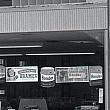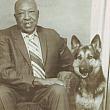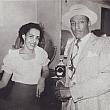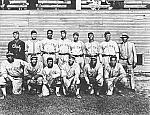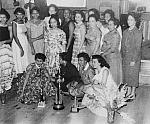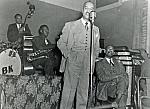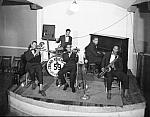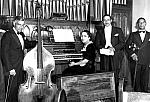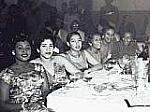
"Chitlin' Circuit" Performers Come to Roma Hall
by Kim Rush, John Russo, and Martin Starr
From the 1936 until the 1980s Roma Hall was rented regularly by Grand Rapids’ African American community for a wide variety of events that included weekend public dances, featuring high profile musicians, jam sessions, weddings, black cotillion debutante balls, political rallies, NAACP and Urban League meetings, dinners, meetings, conventions, parties, and concerts, golf league award dinners, and fashion shows. Reportedly, Emma Latimore held fashion shows at Roma Hall.
Nationally renowned performers including Muddy Waters, B.B. King, and Mary Wells performed for Roma Hall audiences in the 1950s and 1960s. When Motown Record’s first star, Mary Wells, came to perform at Roma Hall, she was escorted by limousine and accompanied by the label’s owner and producer Berry Gordy. Joe Russo’s son Frank was working at the pizzeria underneath Roma Hall when The Primettes, an early version of the Supremes, stopped there for dinner after they performed. They were the opening act for Mary Wells that night.
Richard Weatherford, a photographer for The Grand Rapids Times during the earliest days of the newspaper, has stated that he booked Muddy Waters at Roma Hall. Charles Lyons was also involved with sponsoring Roma Hall dances. It is also likely that African American community leaders like Frank LaMar and Ted Rasberry put up the money for some of these events, but this has not been well documented. Grand Rapids resident Tom Mosley was a blues singer, guitarist and harmonica player for Little Wolf and the Gully Jumpers, a local blues band, from the early 50s until 1970. He states that his band opened for Muddy Waters at a dance “above the dime store (Fred Blymeir 5 & 10) at Russo’s Roma Hall. This is where I met Muddy Waters and James Cotton.”
Lee Virgins, who was a doo-wop, soul and gospel singer in Grand Rapids since the 50s, is a close friend of soul and gospel recording legend Al Green. He sang with him at Roma Hall and the American Legion before Al became famous, and now books gospel music shows. Virgins clearly recalls a memorable dance at Roma Hall. In 1955, he was only twelve years old when B.B. King came to play there. He maintains that the sponsors for these dances would acquire temporary (24 hour) beer licenses for these events.
Blues vocalist Bobby Blue Bland also played there in November of 1962. Reportedly, Jimmy Reed, Lavern Baker, Ruth Brown, Ray Charles, Tiny Bradshaw, T- Bone Walker, Percy Sledge, Lloyd Price, Amos Milburn, Lowell Folsum and Nappy Brown all appeared there, too, based on accounts by Jessie Strickland, Doug Cook, Tom Mosley, J.C. Carter, Annie Gant, Benny Keys, Jr., Lee Virgins, Raphael Gooch, and others.
At least some confusion exists concerning who actually performed at Roma Hall because of the close proximity of another nearby musical venue named the Rose Room, which was open for business in 1953. At that time, Joshua “Pop” Haynes remodeled the Franklin Theater into a dance venue. The Rose Room was located at 814 South Division and was situated on the same side of the street as Roma Hall.
These nightspots were no more than 300 feet from each other. Annie Gant clearly recalled seeing B.B. King at the Rose Room. Doug Cook saw B.B King at Roma Hall. Lee Virgins remembers B.B. King’s tour bus parked on Franklin Street, with a black and white television inside the bus. Furthermore, he helped haul King’s band’s equipment up the Roma Hall stairs. So it is quite likely that B.B. played at both places. Lee Virgins relates that in 1962 James Brown and the Famous Flames came to play at the Rose Room. Brown arrived in a 1954 Ford station wagon, and Lee helped the band move their equipment into the building.
John Russo recalls that Frank Lamar gave him and his brothers rides in one of Frank Lamar’s new twin 1957 Cadillacs while Roma Hall was being set up for an event that Frank was sponsoring. Frank was a friend of the Russo family, and occasionally would enjoy dinner with G.B. and his family. John: “there were many African-American events which were held at our hall, sponsored by community leaders like Frank and Ted Raspberry.”
During the mid 1960s, when Al Green was still living in Grand Rapids and before he became famous, WERX radio station would hold dances at Roma Hall with Al Green and the Creations, and occasionally with recording stars like Major Lance performing. Lloyd Brown, also known as “Dr. Soul,” was a disc jockey for WERX at that time, and was involved with these dances. He was also a talented singer and drummer that performed in Grand Rapids at clubs like the Blue Note and The Mouse Trap.
Around 1970, Little Wolf and the Gullyjumpers, Fred (Johnson) and the Groovers and veteran bluesman Johnny Littlejohn supplied blues music for a weekend dance at Roma Hall.
The End of Roma Hall
John Russo: “The Roma Hall was seldom used in the days just previous to the demolition of the property, but when it was rented it was mostly for African-American dances. But there was so much deterioration of the property that it no longer passed city codes and we eventually couldn't use it anymore. The building seemed pretty solid until its last few years. Then I could start to see sagging of the roof in the front rooms upstairs. I always thought that the rear addition of the big porch behind the main apartment was poorly constructed, especially the narrow balcony/walkway next to the big window that let sun into the porch. My grandparents grew a fig tree in a big barrel on this porch that was still there when the building was torn down. I remember eating the figs when I was a kid. My grandmother also planted fresh basil in that same barrel and these two plants cross-pollinated.”
Though it was only one of G.B.’s numerous business adventures, Roma Hall was used for a plethora of purposes. During five decades, it served several ethnic groups. Giovannina (Jennie) Russo, G.B.’s second wife and the family business bookkeeper, saved a generous quantity of business and family memorabilia including ledger books, some related to bookings at Roma Hall. Many of these items were stored in the vicinity of the hall, finally becoming part of the rubble that was hauled away during the demolition process.

 facebook
facebook